Dispatch: Episodes 1&2 first impressions
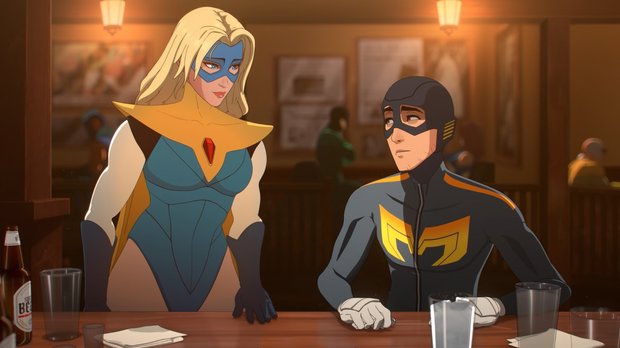
- 0 Comments
When the reveal trailer for Dispatch debuted, it didn’t take much more to get me excited than the lines describing developer AdHoc Studio as “… (some of) the people that brought you The Walking Dead, The Wolf Among Us, and Tales from the Borderlands (the first one).” These are easily three of the best series ever put out by Telltale Games, and to say my hopes for Dispatch were high is a massive understatement. Yet even with that awfully high bar set, I am incredibly happy to report that the fine folks at AdHoc have done it – at least so far. The first two of eight planned episodes have met my lofty expectations, and in a lot of ways even surpass those modern classics by charting its own course and pushing beyond the narrow design structure that characterized its vaunted predecessors.
Dispatch is about superheroes but is not your average superhero story. You play as Robert Robertson, a regular guy without special powers living in what appears to be an alternate universe 1980s Los Angeles, where superheroes and supervillains are an everyday part of life. Robert is the third generation of men in his family to don a state-of-the-art iron suit to become Mecha Man. Both previous Mecha Men fell in battle, with Robert’s dad killed by an old ally turned supervillain, now known as Shroud. Robert has been tracking Shroud for years to bring him to justice, but when he finally locates the hideout, he discovers too late that it was a trap planned by Shroud to take him and the mech suit down for good. Robert barely escapes with his life, but his suit is completely destroyed – and since Robert’s broke, he can’t afford the materials needed to rebuild it. In a public press conference, Robert announces that Mecha Man is no more.
Or, he would be if Robert didn’t receive a surprise visit from local superhero celebrity, Blonde Blazer. She was given an assignment from her employers at the Superhero Dispatch Network (SDN) to recruit the newly suitless Mecha Man as a dispatcher – not leading the way but staying behind and sending other heroes out to help those in need, in a town where all too many things go wrong for the good guys to help all at once. Blonde Blazer makes Robert an offer he can’t refuse: if he works for SDN, they will give him access to their resources to rebuild the Mecha Man suit. Of course he accepts the job, but on his first day he discovers that his super “hero” team actually consists of (barely) reformed supervillains from the Phoenix Program, which offers convicts the option outside of prison time to work with SDN. Unsurprisingly, having a bunch of baddies as your group of dispatch-ees leads to some… problems. But Robert Robertson is up for the challenge.
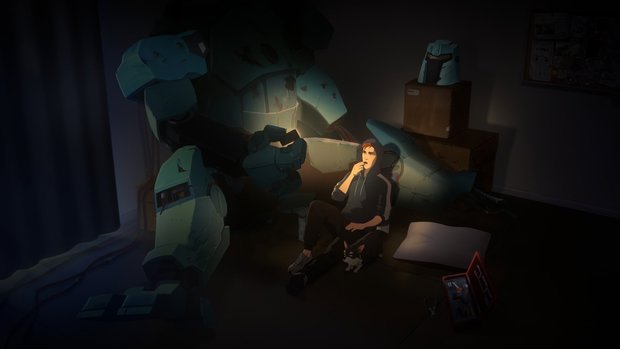
Gameplay in Dispatch is split up between three different elements: typical Telltale-like story-rich sequences where you make choices in dialogue that change how the narrative plays out, a fun but simple computer hacking minigame to unlock barriers and open new pathways for your team while they’re in the field, and the dispatching sections where you send out your charges to perform tasks for callers requesting SDN aid. Anyone who has played one of Telltale’s narrative game series will feel right at home as the story and dialogue play out (except here there’s an option to turn off quick time events, which I very much appreciated), but the hacking minigame and dispatching sections are entirely their own thing.
Hacking is pretty simplistic so far. Via keyboard/mouse or gamepad, you control a small sphere being moved around a maze of blue lines, where every few steps there’s some sort of interactive node that pops up (i.e. a key, a switcher that moves around the available nodes to travel to, etc.). Most of them require you to press some kind of input button or key, which once completed will unlock their corresponding effect. When you make your way to the end of the hacking course, your sphere will crash down and unlock your hacking target. Dispatch’s world is a retro sci-fi wonderland of technologies connected to various aspects of everyday life: so far I’ve hacked a sprinkler system and a supervillain’s computer.
Dispatching heroes is a much more involved experience, in which a wire frame map of Los Angeles pops up. A pool of heroes is shown as character icons along the bottom of the screen, and each has a set of stats that differ depending on what a character’s strengths and weaknesses are (power, charisma, speed, endurance, and so on). As you attempt to juggle responses, various calls to SDN will come up in real time from individuals asking for aid. These range anywhere from taking down a supervillain crime syndicate to helping an old lady get to her doctor’s appointment on time.
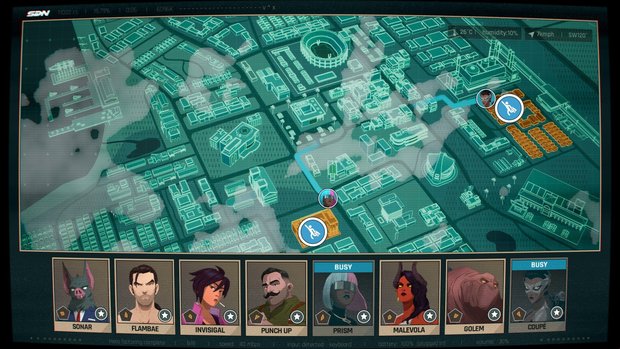
Once you’ve chosen a distress call to tackle (highlighted by an exclamation point on your map), you’ll see the skills best suited for the situation, along with one or more slots to assign heroes from your available pool to confront the threat. Calls with lower difficulty have fewer slots available, so you can’t send three superheroes to go get a cat out of a tree when one can easily complete the task. Once a hero has been assigned, they will be unavailable until their current objective is finished (shown by a meter next to the location on your map). Sometimes additional issues will come up that require more direct assistance from you as a dispatcher. For example, a hero may need advice on how to deal with a teen that stole someone’s wallet and got apprehended.
After completing a task, your heroes will return to SDN headquarters to rest and recharge. While they relax, a meter is shown next to their icon at the bottom of the screen, indicating when they will be ready for another mission. Their last completed assignment will be checked off on your map, and clicking on it shows you the performance review of the hero or heroes you assigned. A graph displays the skills needed to combat the task, fully or partly filled in with the skillset of whomever you sent out to handle it. A ball will bounce around the graph at random, and if it lands where the hero graph overlaps the task graph, your hero(es) successfully completed the job. If the ball lands outside area, the attempt failed instead. At the end of each dispatching sequence, you receive various awards for doing a job well, but in keeping with Telltale precedent, there’s no wrong way to proceed – the story continues moving forward even if you botch every distress call.
In the first episode, you play through a tutorial sequence that has you controlling a group of elite superheroes. These teammates all act suitably noble and respond with encouraging affirmations of your incredible skill in choosing the right hero for the job. In the second episode, you control your own team of ex-supervillains – though I use the term “control” here very loosely. These malcontents might follow your orders when you ask them to check out a location or head towards a specific distress call, but sometimes members like the hot-headed Flambae will run off to do their own thing, causing further issues that the rest of the team has to deal with.
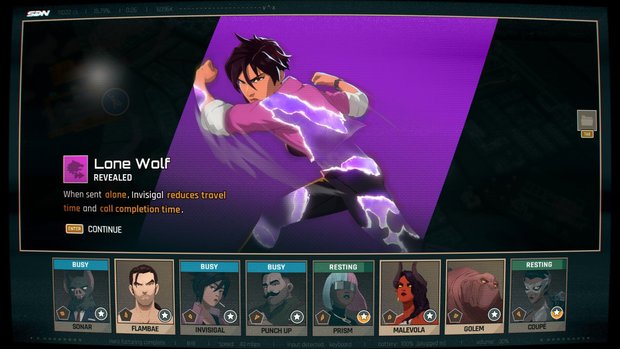
There have been only two dispatch sequences (one per episode) so far, but the way they differ in tone ingeniously sets the stage for the fact that your team consists of supervillains grudgingly serving time at SDN, not a well-coordinated force of eager do-gooders. There is constant chatter – fully voiced with wonderful acting all around – between team members during these sequences as well. This makes the fieldwork feel like an immersive part of the overall story experience rather than a weird break between the traditional narrative gameplay back at the office and elsewhere that makes up the majority of Dispatch’s episodes. I have not yet had the opportunity to walk freely around the 3D space like in a standard adventure (or even occasionally in Telltale’s), but the many animated interactions between Robert and an already huge cast of characters are a treat.
And holy crap, the animation in this game is gorgeous. Like a cel-shaded interactive cartoon TV series, the 3D environments, character details and art are all incredible. I mentioned earlier that there are quick time events that can be turned off, but if you leave them on they are primarily used during the wonderful fight sequences between the heroes and villains of Dispatch going toe to toe with each other. So far there has been one superhero battle per episode, and the production value for the fight choreography is off the charts.
Even in their downtime, characters are expressively animated in a way that evokes the purposefully lower frame count visual style popularized by the Spider-Verse movies. And they always have engaging things to say. Individuals crack jokes in ways that feel natural in a setting where everyone is used to superpowers just being a thing that exists, and it’s such a joy just to inhabit the world AdHoc has crafted. The writing is top notch, with some very funny dialogue that elicited some genuine laughs out of me.
Already this early in the story, strong character personalities are depicted with playful dynamics. Invisigal having her superhero name changed to “gal” by Blonde Blazer rather than the less-than-PG name she had as a supervillain is immediately hilarious, while at the same time showing a glimpse of her personality and life before the Phoenix Program. Fellow dispatcher Chase has some deep history with Robert that I won’t get into here, but just what has been revealed in two episodes so far has me itching to know more about what they’ve been through. Royd is already a personal favorite of mine, being a huge hulking dude with a heart of gold but the brain cell count of an orange cat, but there honestly isn’t a single weak link in the cast, and I cannot wait to find out where the story takes them.
In fact, while it remains to be seen if the good vibes established early on will carry through all eight episodes, for now there’s been nothing negative about my experience with Dispatch. There is some nudity and strong language throughout, as it’s intended to be an adult superhero story, but even then there’s an option to censor the experience for those who want it less risqué. The first two installments are roughly an hour each, so they don’t overstay their welcome and can easily be completed within a week. By then it’ll be time for the next pair of episodes to drop, making this a user-friendly episodic experience even for early adopters. I’ll be eagerly awaiting the upcoming episodes to hop back into the dispatcher’s chair, so stay tuned for a final review once the full game is released.




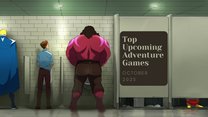





0 Comments
Want to join the discussion? Leave a comment as guest, sign in or register.
Leave a comment